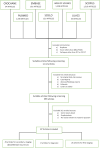68Ga-Prostate-specific membrane antigen (psma) positron emission tomography (pet) in prostate cancer: a systematic review and meta-analysis
- PMID: 33566470
- PMCID: PMC8321470
- DOI: 10.1590/S1677-5538.IBJU.2019.0817
68Ga-Prostate-specific membrane antigen (psma) positron emission tomography (pet) in prostate cancer: a systematic review and meta-analysis
Abstract
Introduction: Prostate cancer (PC) is the second most commonly diagnosed cancer in males. 68Ga-PSMA PET/CT, a non-invasive diagnostic tool to evaluate PC with prostate-specific membrane antigen (PSMA) expression, has emerged as a more accurate alternative to assess disease staging. We aimed to identify predictors of positive 68Ga-PSMA PET and the accuracy of this technique.
Materials and methods: Diagnostic accuracy cross-sectional study with prospective and retrospective approaches. We performed a comprehensive literature search on PubMed, Cochrane Library, and Embase database in search of studies including PC patients submitted to radical prostatectomy or radiotherapy with curative intent and presented biochemical recurrence following ASTRO 1996 criteria. A total of 35 studies involving 3910 patients submitted to 68-Ga-PSMA PET were included and independently assessed by two authors: 8 studies on diagnosis, four on staging, and 23 studies on restaging purposes. The significance level was α=0.05.
Results: pooled sensitivity and specificity were 0.90 (0.86-0.93) and 0.90 (0.82-0.96), respectively, for diagnostic purposes; as for staging, pooled sensitivity and specificity were 0.93 (0.86-0.98) and 0.96 (0.92-0.99), respectively. In the restaging scenario, pooled sensitivity and specificity were 0.76 (0.74-0.78) and 0.45 (0.27-0.58), respectively, considering the identification of prostate cancer in each described situation. We also obtained specificity and sensitivity results for PSA subdivisions.
Conclusion: 68Ga-PSMA PET provides higher sensitivity and specificity than traditional imaging for prostate cancer.
Keywords: (225)Ac-PSMA-617 [Supplementary Concept]; Glu-NH-CO-NH-Lys-(Ahx)-((68)Ga(HBED-CC)) [Supplementary Concept]; Prostate cancer, familial [Supplementary Concept].
Copyright® by the International Brazilian Journal of Urology.
Conflict of interest statement
None declared.
Figures









Comment in
-
Editorial Comment: 68Ga-Prostate-specific membrane antigen (PSMA) positron emission tomography (pet) in prostate cancer: a systematic review and meta-analysis.Int Braz J Urol. 2021 Jul-Aug;47(4):730-732. doi: 10.1590/S1677-5538.IBJU.2019.0817.1. Int Braz J Urol. 2021. PMID: 33848065 Free PMC article. No abstract available.
References
-
- 2. [No authors]. National Cancer Institute Surveillance, Epidemiology, and ERP. Cancer Stat Facts: Prostate Cancer. NIH. [Internet]. Availlable at <https://seer.cancer.gov/statfacts/html/prost.html>.
-
- 3. Perera M, Papa N, Christidis D, Wetherell D, Hofman MS, Murphy DG, et al. Sensitivity, Specificity, and Predictors of Positive 68Ga-Prostate-specific Membrane Antigen Positron Emission Tomography in Advanced Prostate Cancer: A Systematic Review and Meta-analysis. Eur Urol. 2016; 70:926-37. - PubMed
-
- 4. Umbehr MH, Müntener M, Hany T, Sulser T, Bachmann LM. The role of 11C-choline and 18F-fluorocholine positron emission tomography (PET) and PET/CT in prostate cancer: a systematic review and meta-analysis. Eur Urol. 2013; 64:106-17. - PubMed
Publication types
MeSH terms
Substances
LinkOut - more resources
Full Text Sources
Medical
Research Materials
Miscellaneous
